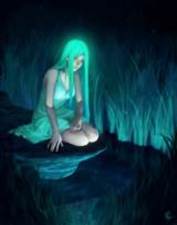
The Nyx/Nixie (German: Nix/Nixie/Nyx, Norwegian: Nøkk or plural: Nøkken) are shapeshifting water spirits who usually appear in human form. These spirits have appeared in the myths and legends of all Germanic peoples in Europe. Although perhaps most known in Norwegian and Scandinavian folklore. In recent times such creatures have usually been depicted as human in shape (albeit in many cases shapeshifting). However, the English Knucker is generally depicted as a wyrm or dragon, thus attesting to the survival of the other usage as any "water-being" rather than an exclusively humanoid creature. Their gender, bynames, and various animal-like transformations vary geographically. The German Nix and his Scandinavian counterparts are males. The German Nixe or Nixie is a female river mermaid
The names are held to derive from Common Germanic *nikwus or *nikwis(i), derived from PIE *neigw ("to wash"). It is related to Sanskrit nḗnēkti, Greek νίζω nízō and νίπτω níptō, and Irish nigh' (all meaning to wash or be washed). The form neck appears in English and Swedish (näck or nek). The Swedish form is derived from Old Swedish neker, which corresponds to Old Icelandic nykr (gen. nykrs), and nykk in Norwegian Nynorsk. In Finnish, the word is näkki. In Old Danish, the form was nikke and in modern Danish and Norwegian Bokmål it is nøkk. The Icelandic nykur is a horselike creature.
The Scandinavian näcken, näkki, nøkk, nøkken, strömkarl, Grim or Fosse-Grim were male water spirits who played enchanted songs on the violin, luring women and children to drown in lakes or streams. However, not all of these spirits were necessarily malevolent; in fact, many stories exist that indicate at the very least that nøkken were entirely harmless to their audience and attracted not only women and children, but men as well with their sweet songs. Stories also exist where in the Fossegrim agreed to live with a human who had fallen in love with him, but many of these stories ended with the nøkken returning to his home, usually a nearby waterfall or brook. (Compare the legend of Llyn y Fan Fach in Wales.) Nøkken are said to grow despondent if they do not have free, regular contact with a water source.
It is difficult to describe the actual appearance of the nix, as one of his central attributes was thought to be shapeshifting. Perhaps he did not have any true shape. He could show himself as a man playing the violin in brooks and waterfalls (though often imagined as fair and naked today, in actual folklore he was more frequently wearing more or less elegant clothing) but also could appear to be treasure or various floating objects or as an animal—most commonly in the form of a "brook horse".
The modern Scandinavian names are derived from an Old Norse nykr, meaning "river horse." Thus, likely the brook horse preceded the personification of the nix as the "man in the rapids". Fossegrim and derivatives were almost always portrayed as especially beautiful young men, whose clothing (or lack there of) varied widely from story to story.
The German Nix and Nixe (and Nixie) are types of river merman and mermaid who may lure men to drown, like the Scandinavian type, akin to the Celtic Melusine and similar to the Greek Siren. The German epic Nibelungenlied mentions the Nix in connection with the Danube, as early as 1180 to 1210.
Nixes in folklore became water sprites who try to lure people into the water. The males can assume many different shapes, including that of a human, fish, and snake. The females are beautiful women with the tail of a fish. When they are in human forms, they can be recognised by the wet hem of their clothes. The Nixes are portrayed as malicious in some stories but harmless and friendly in others.



 The Nyx/Nixie (German: Nix/Nixie/Nyx, Norwegian: Nøkk or plural: Nøkken) are shapeshifting water spirits who usually appear in human form. These spirits have appeared in the myths and legends of all Germanic peoples in Europe. Although perhaps most known in Norwegian and Scandinavian folklore. In recent times such creatures have usually been depicted as human in shape (albeit in many cases shapeshifting). However, the English Knucker is generally depicted as a wyrm or dragon, thus attesting to the survival of the other usage as any "water-being" rather than an exclusively humanoid creature. Their gender, bynames, and various animal-like transformations vary geographically. The German Nix and his Scandinavian counterparts are males. The German Nixe or Nixie is a female river mermaid
The Nyx/Nixie (German: Nix/Nixie/Nyx, Norwegian: Nøkk or plural: Nøkken) are shapeshifting water spirits who usually appear in human form. These spirits have appeared in the myths and legends of all Germanic peoples in Europe. Although perhaps most known in Norwegian and Scandinavian folklore. In recent times such creatures have usually been depicted as human in shape (albeit in many cases shapeshifting). However, the English Knucker is generally depicted as a wyrm or dragon, thus attesting to the survival of the other usage as any "water-being" rather than an exclusively humanoid creature. Their gender, bynames, and various animal-like transformations vary geographically. The German Nix and his Scandinavian counterparts are males. The German Nixe or Nixie is a female river mermaid
 Edited by Uranicus_Angelus
Edited by Uranicus_Angelus